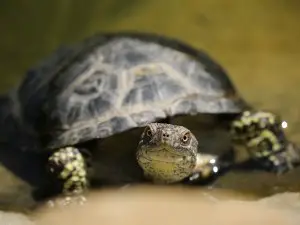
Noticing and watching your pet turtle’s shell turn black can be quite concerning for any turtle owner and raiser. While these animals sport a number of different shell colors a change to black will be a concerning
This article looks into why your turtle’s shell is turning black
Table of Contents
Why is my turtle shell turning black?
Understanding the potential causes of the blackening of your turtle’s shell will empower you to take proactive steps to address this issue, but you need to know why this is happening first
Here is why this may be happening with your turtle:
Turning into adults:
If you’re currently taking care of a young turtle and its shell was once yellow or green, but is black now, then this can simply be attributed to the animal becoming an adult.
Turtles that sport these bright colors in youth usually develop shells of a darker color as they get older. Red-eared sliders usually experience this color change.
What to do:
You don’t have to do anything if you see this happening to your turtle, this is perfectly normal and healthy for your pet and is something that should be expected.
As long as this black color change is normal for your species of turtle then your pet should be fine.
Black substrate:
Turtles have been observed changing the colors of their shells to match the substrate of their enclosure, this is a survival technique that would help them blend into the environment and keep predators from finding them very easily.
If the substrate in your pet’s enclosure is black then your pet may have changed its shell color to match the substrate.
What to do:
This may seem quite odd but it’s a pretty common phenomenon, you don’t have to worry if you see your pet going through this. As long as the animal is healthy and is acting normally then your pet is fine
Black algae:
Another reason why your turtle’s shell may be turning black may be because black algae is growing on the animal’s shell.
Algae can grow on almost any surface, including your turtle’s shell. Algae can also come in a variety of colors including black.
What to do:
The algae won’t directly harm the turtle but it can prevent the animal from absorbing heat from its basking lamp as well as the UV rays from the lamp. This can be dangerous for the animal’s body so removing the algae is recommended
You can use a soft toothbrush and room-temperature water to rub the animal’s shell and get the algae off. This may take some time, be patient and gentle when doing this.
Changing your pet’s water and cleaning the tank regularly should help to keep algae at bay.
Age:
Another reason why your pet’s shell may be turning black is because it is growing old. The shells of these animals change with age, they can become a duller color or a darker color.
The shells of older turtles turn darker because their shells have been exposed to sunlight, which makes them darker, for a longer period of time.
What to do:
You don’t have to do anything in this situation, this is quite a normal thing that happens to older turtles and isn’t something to worry about.
As long as the animals are healthy, and don’t show signs of distress or illness then your pet is likely perfectly fine, it’s just old.
If you enjoyed this article then you may also be interested in other turtle/tortoise related articles. Here are some articles that you may be interested in: Why Are My Turtle’s Eyes Cloudy?, Why Are My Turtle’s Eyes White?, Why Is My Turtle’s Shell Turning Brown?, Why Is My Turtle Shell Chipping, Why Is My Turtle’s Shell Coming Off?, Why Is My Turtle Biting His Shell?, My Baby Turtle Won’t Eat, Why Is My Turtles Skin Dry, Is My Turtle’s Shell Healthy?

